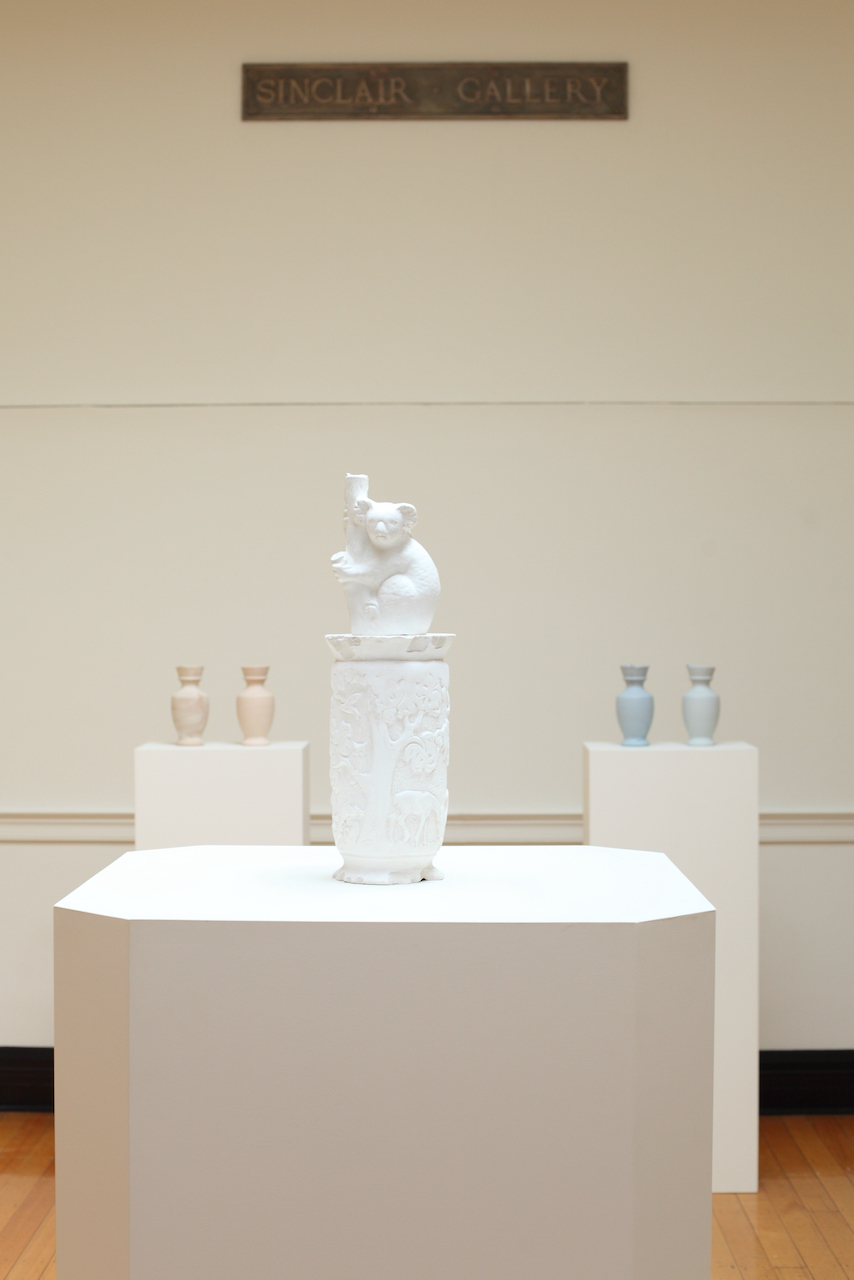Reflection - Sequeira on Moon
What gesture should galleries adopt to celebrate the opening of an exhibition in the time of Covid-19, when social distancing precludes the delightful tradition of an exhibition opening? While nothing can replace the conviviality of gathering in the Sinclair Gallery with the artist and a glass of wine, today we offer a thoughtful reflection on the key work in Moon’s exhibition, by artist and gallery director, David Sequeira as our opening gesture. We also launched CAM Collectables, our new retail project in the McKillop Gallery. Moon is the first featured artist and will be followed by artists and makers from the region and beyond.

Damon Moon’s Epergne 2020
Imbued with a profound love and understanding of the rich history of ceramics, Damon Moon’s work bridges a range of concerns around high and low art, decoration and function, personal and shared histories, values and ideals. These concerns lie at the heart of Moon’s major work Epergne 2020 currently on view at the Castlemaine Art Museum. A curious sculptural object comprised of a white bisque fired, slip cast koala, atop a bas relief, cylindrical plaster form decorated with deer and squirrels, Epergne suggests a fusion of Australian and non-Australian sensibilities. The depictions of fauna in Moon’s work are not the result of his careful observations of nature. The two elements that form Epergne have been sourced from the wealth of archival material at the Bendigo Pottery where Moon works as Creative Director of the Centre for Learning and Design.
Although uncatalogued, it is likely that Epergne’s plaster base was originally intended as a master model for a mould from which ceramic objects could be cast. However, there is no record of this chipped and worn model being used for this purpose and it gathered dust until ‘discovered’ by Moon in 2019. The art deco styling of animals and landscape and its scale and form suggest it may have been designed in the 1930s as a vase, lamp base or architectural detail - the slip cast koala is made from one of Bendigo Pottery’s current moulds. Part of a tradition of ‘Australiana’ objects, manufactured extensively by the Bendigo Pottery in the 1930s and 40s, the design of the koala has changed little over time. Juxtaposing two objects from a vast range of moulds and prototypes, Epergne demonstrates Moon’s interest in making sense of historical material. Although both elements began life in the same place and time, one was discarded when it was little more than a conceptualisation whilst the other continues to be embedded in Australia’s national psyche.
The title of the work, Epergne, refers to an ornamental table centrepiece. Highly popular in the 19th century, epergnes were typically elaborate, multi branched silver and glass constructions designed to hold fruit and flowers. Layered both in structure and metaphor, these epergnes suggested taste, wealth and bounty. This sense of elegance and refinement is absent in Moon’s modest plaster and ceramic sculpture. Without colour, Epergne looks unfinished - a work in progress or an experiment in its most minimal state. Moon’s concerns seem to lie in notions of the claimed and the vernacular. The materials that constitute Epergne are the work of unknown makers and Moon’s role as artist can be understood as that of an improbable archivist who creates unlikely connections and resonances from seemingly disparate objects.
Whilst visually simple, Epergne is underpinned by an inquiry into an uneasy relationship between Australian and non-Australian landscape. The European or American woodland narrative that decorates the base of the sculpture is in direct contrast to the koala that it supports. Appearing as if being observed, the deer, hare and squirrels sculpted into the base are passive in comparison to the koala who stares out to the viewer. The flat woodland animals seem relaxed whilst the three-dimensional koala (normally associated with drowsiness) appears vigilant and on edge. Epergne echoes the form of a funerary urn, and the koala motif has particular potency in light of the recent Australian bushfires in which thousands of koalas burnt to death.
Damon Moon’s Epergne is a heady blend of sentimentality, nostalgia and romanticism. Layered with ideas of hybridity, post colonialism and kitsch, the work calls viewers to (re)consider their understanding of and relationship with Australian art history. More specifically, the work points towards the ways in which everyday objects contribute to a fuller picture of Australian culture.
David Sequeira
June 2020